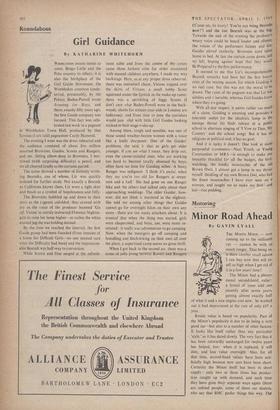Motoring
Minor Road Ahead
By GAVIN LYALL
THE Morris Minor — now coming up to the millionth car — cannot be with Os much longer. That being so, is there another small saloon I can buy now that will re- sell as high when I get rid of it in a few years' time?
Resale value is based on popularity. Part of the Minor's popularity is due to its being a very good car—but also to a number of other factors. It looks like itself rather than any particular 'style,' so it has dated slowly. The very fact that it has been outwardly unchanged for twelve years has helped, too : when it is replaced, it will date, and lose value overnight. Also, for all that time, second-hand values have been arti- ficially high because new cars have been short. Certainly the Minor itself has been in short supply : only two or three times has produc- tion caught up with demand, and each time they have gone their separate ways again (there are unkind people, some of them car dealers, who say that BMC prefer things this way. The
best advertisement for a car is that it should be in short supply). And finally, its price is right: around and just over £600 is, for a 1,000 c.c. car, a standard most of us accept. Not all these factors will apply with the same force over the next ten years: no small car is likely to be as much better than the rest as the Minor was in 1948, and sooner or later the new- car shortage has got to end. But if we're going to- Play spot-the-next-Minor, I would play it
with the Austin A40 and the Triumph Herald.
Both are 1,000 c.c. saloons, both have perform- ances very similar to the Minor: top speed (taking the single-carburettor Herald as a guide) around 70 m.p.h., consumption around 40 nt.P.8. (the Minor is best, the Herald worst, of the
three).
The A40 has also the Minor's trick of looking like itself, but from the inside and on the road, I think, the Herald has the lead. It is firmer to drive, quieter, has a smaller turning circle for a similar length. It has a fitted heater, window Winders (against the A40's utilitarian push-pull .knob) and a generally lusher interior. It is easier and cheaper to repair and, having a true chassis,
safer and less likely to collapse in a crash—and this should help to keep it in better condition Innger.
But this isn't quite what we're talking about: a buyer does nut conduct elaborate road tests, and many of the Herald's advantages may, to
that buyer, lie hidden under bushels. Will he, for instance, see the point of having a chassis. or Prefer the few extra miles-per-gallon of the A40? Will he appreciate independent rear. suspension (1 don't, not on British roads) or simply notice that, new, the Herald costs £60 more than -the k40? (A number of• dealers agree that the Herald's price is too high for .its, own good. Flicking £702, just over the £700 mark, certainly seems rotten sales psychology. I assume that Triumph knew they could sell the first few thousand on newness alone and that thereafter ---,soon, in fact—the price-will drop.)
' The extent of this drop could .make it lot of difference. If it is not enough, and if the boys
at BMC really want to do sonic work on the A40's trim, steering and- soundproofing (and a lot of similar work has been done on the Minor iii its lifetime) then, for better or worse, I think the A40 will. have it.
Readers planning to take cars abroad this summer can get a lot of help in the planning— and the journey—from the oil companies' tour- ing services. These, for 1960, are as follows, and all, except for BP, free.
Shell: ask at a petrol station carrying their touring symbol for an addressed card, send in for : small-scale •`planning map' of Europe, large-scale maps of countries to be toured and phrase-book. Over there, call at Shell stations for local guide pamphlets and tour plans.
Esso :. call for card as above, send to Paris, get in return : planning map, maps of countries to be toured, each marked (if you ask) with alternative scenic and direct routes to and from
your destination, plus various other pamph1,1,-..
BP: pay 10s. at a BP station for 'plannins kit': planning map, European guide book (quite a good one), free accident insurance, convey-. sation guide, metric conversion tables, a number .of other pamphlets and a gadget like a miniature. toilet roll on which you draw out your route is advance, reel up, then Unieel as you go. °vet there, call at BP Stations fiir maps of the .couturs- itself.
All the maps conCeroed arc good ones for motoring— and if you like:plenty of pamphlett and gadgets, the HP kit is 'good value. The more curious, therefore, that theft service doesn't give you the map of a 'locality 'until you're on it



































 Previous page
Previous page